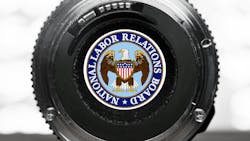Analysis
It has been quite some time since official business in Washington came to a halt during the dog days of summer, and this year even the hurly burly of national elections doesn’t seem to slow down the bureaucracy in many cases. That’s been especially true this year when it comes to the National Labor Relations Board (NLRB).
While the board has pressed ahead with rulemaking proceedings and precedent-setting decisions that plow new ground in federal labor policy, it also has been required to deal with the consequences of pushing beyond the limits deemed acceptable by some courts, and the new limits set by the Supreme Court on federal agencies’ interpretations of laws written by Congress.
For employers, perhaps the most significant recent action was the board’s finalization of a rule that will make it easier for unions to win representation elections while making it more difficult for management to defeat them. The rule also removes one of the last barriers to an employer being ordered by the NLRB to collectively bargain with a union in the absence of a vote by the employees. The final rule goes into effect on Sept. 30.
Earlier this year the board adopted a policy allowing it to recognize union representation by simply declaring that it believes the union organizers when they claim to have signed agreements from the targeted workforce that this is what a majority of the employees want to see happen. This was previously called card check, and the unions that had been seeking it were unable to get a majority in Congress to approve a change in the law that was believed to be required before card check could happen.
The pro-union majority on the current NLRB has long advanced the position that it can order employers to recognize union representation if they are found to have perpetrated an Unfair Labor Practice (ULP) under federal labor law. The filing of ULP complaints by unions during organizing drives is a common occurrence.
The new rule reinstates the board’s earlier and controversial “blocking charge” policy, which permits certain ULP charges to “block” a board-scheduled election—or an employee decertification vote. It also permits the NLRB to remove a 45-day waiting period after granting an employer’s request that a union it negotiated with be allowed to represent the employes in the absence of a vote. Before this rule was adopted, a 45-day waiting period existed that allowed the employees to object to being unionized without a vote.
The practice of blocking a certification (or decertification) vote works to the advantage of unions, by encouraging them to file meritless ULP charges that will halt an election, while allowing them to continue their organizing campaigns during the delay, according to attorneys for the law firm of Sheppard Mullin Richter & Hampton.
During this pause, which could take up to a year to adjudicate the merits of the ULP charge, employers must continue to refrain from making changes to the terms and conditions of its workers’ employment, including wage increases or performance-based bonus payouts, for fear of drawing additional ULP charges.
The NLRB also holds that it can order an employer to recognize and bargain with a union if it is found to have committed a ULP, even if no vote is taken among the employees.
In addition, the final rule makes it easier for construction industry unions to become the exclusive bargaining representative for construction employees based only on contractual language.
In light of many of the board’s changes in recent years, the lawyers say it is important for employers to continue to take a proactive approach in educating supervisors and managers of employee rights and to educate employees on the realities of selecting a union as their exclusive bargaining representative.
In addition, when faced with union organizing activity or election petitions, employers must make extra efforts to avoid engaging in conduct that may give rise to a ULP charge, the attorneys warn.
Joint Employer Rule Pulled
At the end of July, the NLRB surprised legal observers when it withdrew its attempt appeal of a federal court decision blocking implementation of its final rule laying out how two organizations could be defined as joint employers for the purposes of labor law.
The board adopted the rule late last year, which is something that the NLRB’s allies of organized labor have been trying to accomplish since the Obama Administration, but which was stymied during the Trump era. The end result is that the board will continue to adhere to the joint employer policy that had been adopted in 2020 by the Trump NLRB.
If it hadn’t been halted by the court in June, the final rule would have extended the jurisdiction of federal labor law to the parent companies and franchisees of large chain operations like McDonald’s as well as to the customers of personnel staffing firms.
The rule had held that employers could be held to be joint employers in all situations where they “possess the authority to control (whether directly, indirectly, or both), or exercise the power to control (whether directly, indirectly, or both), one or more of the employees’ essential terms and conditions of employment.”
The board also declared that a state of joint employment would exist in situations where two employers “share or co-determine” essential terms and conditions of employment, even if one of the employers possesses only “indirect” or “contractually reserved” control. The new rule extended this reach to include any such authority exercised through an intermediary.
Backing off from the rule at this time doesn’t mean the NLRB intends to abandon the joint employer issue, according to attorney Fiona W. Ong of the law firm of Shawe Rosenthal, who points out that in its dismissal motion, the board asserted that it “would like the opportunity to further consider the issues identified in the district court’s opinion” and “to consider options for addressing the outstanding joint employer matters before it.”
As a result, the ultimate foundation for applying this approach in the future will boil down to who ultimately wins the presidential election this fall, along with control of the Senate and the House of Representatives.
In another rebuff to the NLRB majority over its perceived regulatory overreach, a three-judge panel of the U.S. Fifth Circuit Court of Appeals told the board to reconsider a new standard it had set holding that abusive or inappropriate speech is protected under federal labor, as long as it involves discussions of wages or working conditions.
In a separate matter earlier this year, the Washington, DC, Circuit Court of Appeals wasn’t shy about its opinion of the board’s action when it called the NLRB’s reasoning “nonsense.” The agency had ruled that labor law protections were violated when a supervisor reminded a company driver that he shouldn’t cover onboard cameras, and when it disciplined another employee for using discriminatory language in the workplace.
This action is just one of a series of court rebuffs this year to NLRB enforcement actions, note attorneys Jason Stanevich, Rachel Ring and Ian Beck of the Littler Mendelson law firm, offering a realistic chance to have overreach by the board held in check by courts of appeal in the future.
“At a minimum, employers should seriously consider the basis for eventual appeals from the earliest stage of unfair labor practice litigation, lay the evidentiary foundation for such appeals during trials at the administrative law judge level, and preserve all potential legal arguments during subsequent proceedings before the board,” they recommend.
About the Author

David Sparkman
founding editor
David Sparkman is founding editor of ACWI Advance (www.acwi.org), the newsletter of the American Chain of Warehouses Inc. He also heads David Sparkman Consulting, a Washington D.C. area public relations and communications firm. Prior to these he was director of industry relations for the International Warehouse Logistics Association. Sparkman has also been a freelance writer, specializing in logistics and freight transportation. He has served as vice president of communications for the American Moving and Storage Association, director of communications for the National Private Truck Council, and for two decades with American Trucking Associations on its weekly newspaper, Transport Topics.
